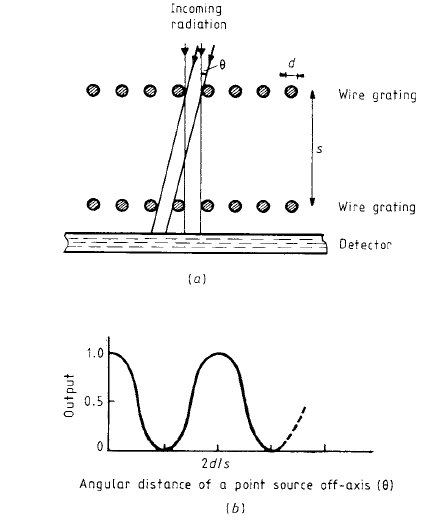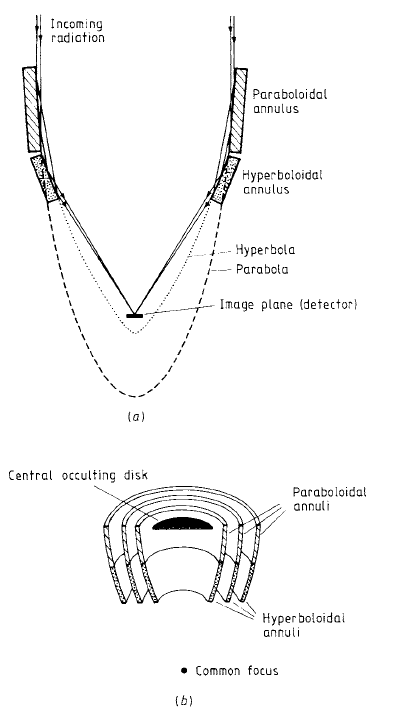
X-ray astronomy: X-ray telescopes
 المؤلف:
A. Roy, D. Clarke
المؤلف:
A. Roy, D. Clarke
 المصدر:
Astronomy - Principles and Practice 4th ed
المصدر:
Astronomy - Principles and Practice 4th ed
 الجزء والصفحة:
p 383
الجزء والصفحة:
p 383
 2-9-2020
2-9-2020
 2205
2205
X-ray astronomy: X-ray telescopes
Imaging of high-energy photons is difficult because of their extreme penetrating power. If the principles of optical design were extended to the x-ray spectrum, reflection surfaces could not be machined to the tolerances of the fraction of the wavelength necessary to obtain sharp images in the focal plane and, in any case, the x-rays would pass through the mirror ! For energies under a few keV, special forms of reflector telescope can be designed. However, for higher energies, the only options for obtaining spatial isolation are occultation, collimation and coincidence detection.
A collimator is a device which physically restricts the field of view. One simple means of doing this is to use a series of baffles in a network of tubes as illustrated in figure 1. The field of view of such a collimator is given by 2w/l, where w is the width of a tube aperture and l the tube length. With this kind of system, typical angular resolution is a few arc minutes. The energy range of this kind

Figure 1. The principle of an x-ray collimator telescope.

Figure 2. (a) The principle of an x-ray modulation telescope, (b) the form of the output signal for a point source as the telescope is panned.
of collimator is limited. For low energies, the x-rays may be reflected off the walls of the tubes, so accepting radiation from a wider range of angles on the sky. For high energies, the radiation can pass through the walls of the tube and any sense of directivity is completely lost.
A more sophisticated system is in the form of the modulation collimator. This comprises two (or more) parallel gratings separated by a small gap. A schematic diagram of the device is depicted in figure2(a). Full intensity is passed when the x-ray source is on axis and also when it is at directions θ given by 2d/s, 4d/s, . . . , etc. If the collimator is scanned across the sky, then a given source will provide a sine-wave modulation as illustrated in figure 2(b). Other sources will provide similar signals but with a phase according to their position in the sky. The addition of several gratings to the system introduces modulations at other frequencies. By investigating the amplitudes and phases of the various frequencies within the combined signal by Fourier analysis, the spatial image and positions of the sources can be mapped. Orthogonal sets of gratings provide a means of determining the twodimensional image distribution.
Direct imaging can also be achieved by using metallic reflection at grazing angles of incidence. The cross section of a simple design is shown in figure 3(a). For 2 keV x-rays, reflection efficiencies of the metal mirrors are the order of 50%. In order to prevent the image plane receiving radiations from objects not on axis, a central occulting disc is required and a larger collection area can be achieved by nesting a series of basic mirror systems as depicted in figure 3(b), the design being referred to as a Woltjer I system.
Following the first detection of celestial x-ray sources by transient rocket platforms, major steps were achieved by the first sky scanning instruments such as UHURU and Ariel V. With the launching of the Einstein Observatory in 1978 with a grazing mirror telescope, the sensitivity was sufficient to

Figure 3. (a) A simple arrangement for an imaging x-ray telescope, (b) the simple imaging principle employed in a nested x-ray telescope.
allow investigation of a significant sample of normal stars and galaxies. The instrument was able to tackle the problem concerning the nature of the diffuse hard x-ray background with the result that it was probably due to a large number of very faint, distant sources, the conclusion being a little more definite for low-energy x-rays.
In the following two decades, satellite missions included EXOSAT, GINGA, ROSAT, ASCA and BeppoSAX but with barely any improvement on spatial resolution. During this period, any imaging was substantially worse by factors between 5 and 50 relative to most other wavelength domains. The situation has now been redressed by ChandraW 23.1 launched by NASA in July 1999 and XMM-NewtonW 23.2 launched by ESA in December 1999. Chandra has provided x-ray images at sub-arc second resolution putting them on a par with pictures by ground-based optical and infrared telescopes. XMM-Newton with its large collection area and multiple nested mirrors is particularly sensitive. Both systems carry grating spectrometers with specially developed CCD chips as detectors. Individual platforms such as HESSI (High Energy Solar Spectrometry and Imaging) have been also been recently launched for extended high-energy x-ray observations of the Sun with high spatial resolution.
As with all other kinds of telescope development, the game is to design instruments with larger collection apertures for better flux gathering and improved angular resolution. It may be noted that the current XEUS design project by ESA plans to increase the effective collection area over the early mission of ROSAT by factors of ∼100 and ∼1000. In order to achieve this, a strategy needs to be developed to assemble the telescopes in orbit. To establish the instruments, the XEUS system will comprise two freeflyers—a mirror spacecraft and a detector spacecraft, separated so that the detector is at the focus of the mirror. The plan is to launch the two vehicles together into a low Earth orbit and to position them by an active orbit control and alignment system.
As the proposed aperture exceeds the capacity of available launch vehicles, the mirror spacecraft will be designed to visit the International Space Station (ISS) to build it up with additional modules that are launched separately. To achieve this, the detector vehicle will have the ability to dock with the mirror spacecraft, after which the mirror spacecraft can dock with the ISS for refurbishment and for the mirror aperture to be further increased, thus converting XEUS1 to XEUS2 with an additional collection aperture some ×10 larger. The detector vehicle will be replaceable at any time by launching a new version.
 الاكثر قراءة في مواضيع عامة في علم الفلك
الاكثر قراءة في مواضيع عامة في علم الفلك
 اخر الاخبار
اخر الاخبار
اخبار العتبة العباسية المقدسة


